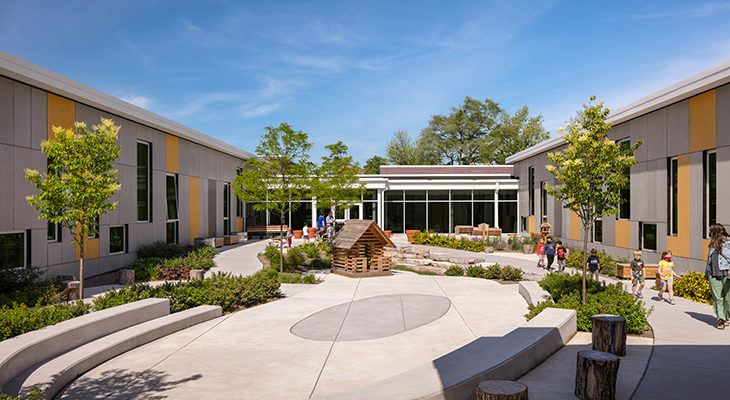
Early learner research and community/teacher/specialist input inspire design of Jefferson Early Childhood Center in Wheaton, Illinois
When three- to five-year-old students look out the child-height classroom windows in Jefferson Early Childhood Center, they never know what they’re going to see in the courtyard at the heart of the school—it could be classmates planting sunflowers in raised beds or adding food in bird feeders. Or it might be butterflies and grasshoppers carrying about their business. This spring, the students even got to monitor the activities of a family of ducks nesting in the courtyard. Students in other classrooms have views to a playground where classmates build independence and confidence on specialized equipment designed with disabilities in mind.
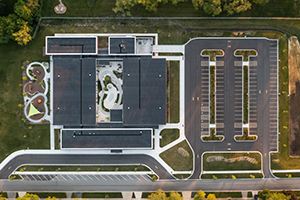
These examples reveal how the new school in Wheaton, Illinois encourages discovery and natural learning opportunities for students of all developmental stages. Evidence of the facility’s focus on the district’s youngest learners appears in everything from the playful facade and integrated therapy spaces to the energetic color scheme and quiet HVAC system.
When students and families enter the school, a colorful wall graphic greets them. It says, “Together may we give our children the roots to grow and the wings to fly.” This spirit of togetherness fueled the design of the school and its focus on Community Unit School District 200’s mission to “inspire, educate, challenge, and support all students to reach their highest levels of learning and personal development.”
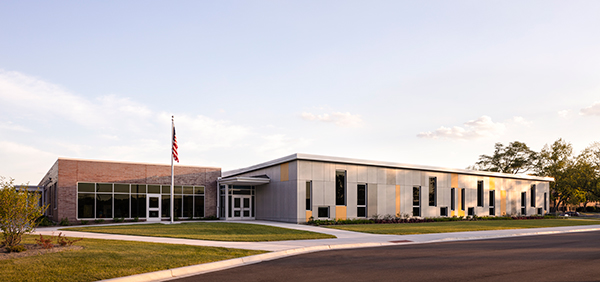
In Love with Learning: Competition-winning Design
The original 60-year-old Jefferson Early Childhood Center was dated, overcrowded, and inefficient. Because the facility was a converted elementary school, it had many hurdles when it came to supporting early learners. For instance, some classrooms did not have toilet rooms so teachers had to interrupt class time to take children down the hallway. The old school was also short on classrooms, as well as therapy and diagnostic spaces. Students had to cross a parking lot to get to a basic playground and there was no indoor play equipment. Additionally, the spaces were not designed for children with special needs—not ideal for Jefferson students, two-thirds of which have special needs or disabilities.
The district launched a competition among prominent Chicago-area educational architects. The challenge: design a replacement school that would cater to the specific needs of Jefferson staff and students. The winning entry was designed by Legat Architects, whose 20-year relationship with the district spans more than 100 projects ranging from renovations at all district schools to design of the new Hubble Middle School.
“Our ultimate goal with the design of Jefferson Early Childhood Center,” said Legat pre-12 leader Robin Randall, “was to get District 200’s youngest students to fall in love with learning.”
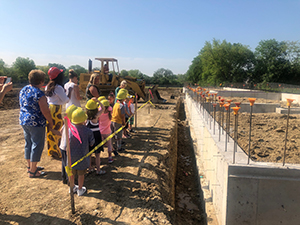
The winning concept, a collection of vibrant indoor and outdoor spaces designed for early learners, was just the beginning—as the project progressed, designers drew from community engagement sessions, Jefferson teacher and specialist input, and early learning research to refine the concept.
In August 2020, district stakeholders, masked and socially distanced, cut the ribbon on the new Jefferson Early Childhood Center in the thick of the COVID-19 pandemic. The facility, funded by a community-backed referendum, kicks off a lifelong learning adventure for District 200’s early learners.
The 43,000-square-foot school was built by Nicholas and Associates adjacent to its predecessor. It offers 16 classrooms, physical therapy space, and a sensory motor room, as well as a community welcome center and resource room for parent education. Most students’ favorite spaces, however, are the outdoor courtyard and playground areas on display throughout the building. The old Jefferson was demolished to create a parking lot and stormwater management area.
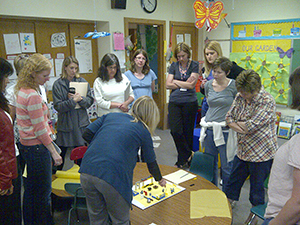
“The success of this project comes down to district input and teamwork,” said Legat project manager Paul Pessetti. “The design committee included not only [district superintendent] Dr. Schuler, Stephanie Mangini, and administrators, but also key Jefferson staff that we met with every week as the design was being developed. It was an inclusive process that allowed us to reach a great solution.”
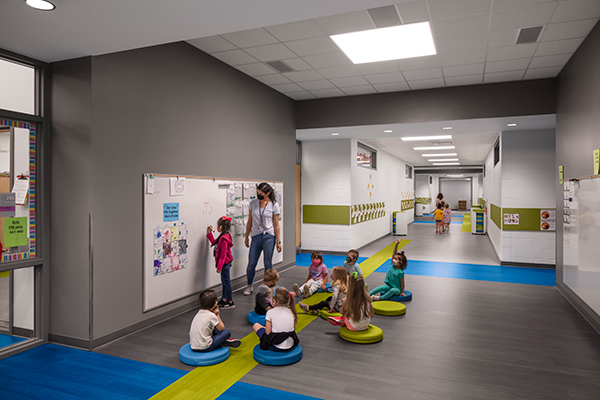
The facility also showcases several environmentally friendly features: lightweight fiber cement panels decrease embodied energy (e.g., the sum of energy required to produce the materials), north- and south-facing classroom windows take in daylight to reduce the lighting and heating loads, and a geothermal field uses 500-feet-deep wells that rely on the earth’s constant temperature to help heat and cool the facility.
Dr. Jeff Schuler said, “It was a tight construction site, meaning we had to work closely with the neighborhood immediately impacted by a lot of construction activity. Now that we’ve completed the project, the immediate neighbors see it as not only a phenomenal educational facility, but also as a true asset to the community.”
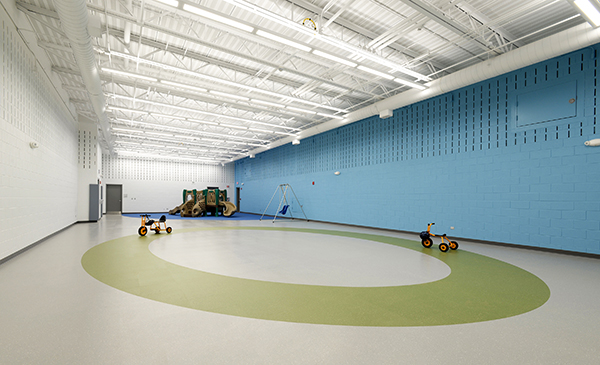
Layout: Exploration and Accessibility
Interior spaces at Jefferson Early Childhood Center are designed around a central courtyard. They include the following:
- Classroom wings (eight classrooms each) to the north and south
- Activity and operations to the west (including a motor skills room that doubles as a tornado shelter)
- Student and family services to the east (including a large, living room-like space that can be used by community members)
Randall said, “The school’s layout taps into young learners’ curiosity, sense of exploration, and innate desire to connect with nature.”
Transparency and openness were key design goals. An occupant in the entry can see through the courtyard to the other side of the building, plus corridors offer views through the classrooms and into the courtyard or playground.
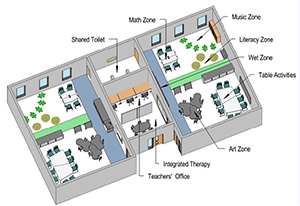
As part of the competition, Legat designed a classroom module to make it a simple, cost-effective system. Each pair of classrooms has a shared core area with a toilet room and an “integrated therapy” space. The therapy spaces, also accessible from corridors, host personalized learning sessions, teacher planning meetings, parent meetings, and much more. They also have windows so teachers within can see classroom activity and students do not feel isolated from their peers. Additionally, because their desks are in the therapy room, teachers can move around classrooms more freely.
Education doesn’t stop within the classrooms—corridor breakout areas offer cushioned seating, whiteboards, magnetic boards, and movable marker racks. The school’s learning resource center/library located off the entry triples the size of the previous library. It features furniture and bookshelves that move easily, enabling the space to support staff and board meetings, as well as parent educational groups.
Unlike the previous facility, the new Jefferson is designed for students of all physical ability levels. Examples range from the entrances and bathrooms to the water fountains and cubbies. A much quieter HVAC system means students with auditory sensitivities are not distracted.
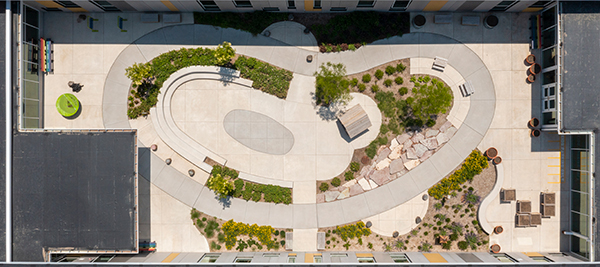
Outdoor Play
The sensory courtyard at the school’s core inspires students to create, explore, and interact. It offers raised benches for different play/instructional activities, a trike track, a sand table, and easels for crafts.
“Students use their imagination and creativity in the courtyard,” said Mangini. “They role play with the log house structure and use a lot of the natural elements to add to their play.”
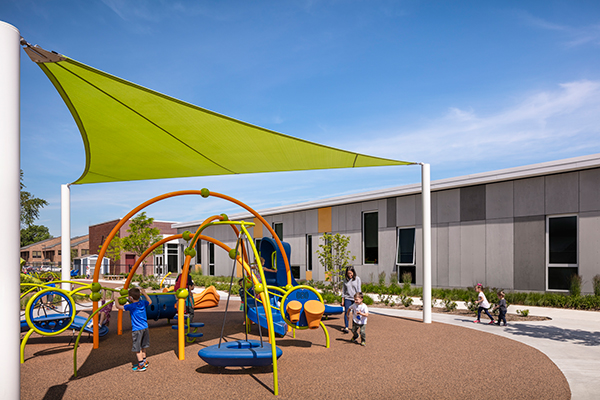
District leadership believed that the courtyard wasn’t enough for Jefferson ECC’s unique student population—it needed another outdoor space to further support the school’s focus on promoting independence and confidence among students of all ability levels. This desire led to the ADA accessible playground, realized thanks to the fundraising efforts of the Jefferson Parent Teacher Association, as well as donations from organizations and individuals.
The inclusive playground, designed based on the input of District 200 occupational and physical therapists, features specialized equipment. For instance, the OmniSpin Spinner offers a safe alternative to the merry-go-round, while the We-Saw reinvents the traditional seesaw. Both devices not only accommodate children who use wheelchairs, but also promote balance, body strength, problem-solving skills, and cooperation for all students.
Schuler said, “The outdoor playground is great for our students during the school day and accessible to the community during off hours.”
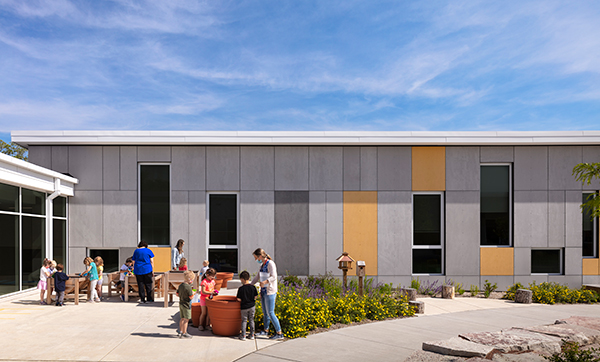
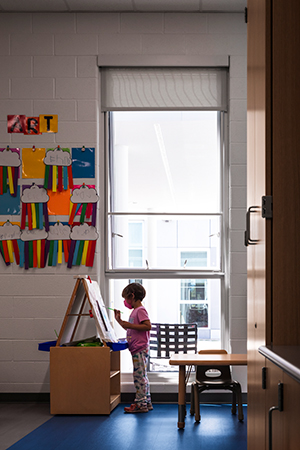
Ergonomic Transposition: Designed from the Students’ Perspective
In many schools, when small children look out windows, they can only see treetops and sky. Not so with Jefferson Early Childhood Center. Designers used a process called “ergonomic transposition,” which considers how small children experience the facility.
Legat’s Loren Johnson said, “When designing spaces for small children, we need to take into account that normal measures like eye height and reach range are different.”
Throughout the Jefferson building, windows are aligned to create moments of discovery. Whereas some areas allow students to see clear through the building, other spots draw their attention to specific natural elements. The concept is most evident in classrooms: higher windows display sky and deliver natural light deep into the space, while lower windows reveal grass and plants.
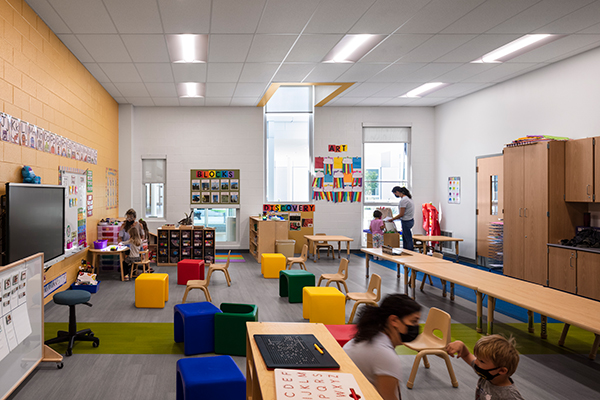
“Students enjoy viewing the courtyard through the lower windows,” said Mangini. “There have been many teachable moments that have occurred based on wildlife that they have seen.”
The design team also relied on ergonomic transposition when designing the corridor, which offers built-in benches, colorful round mats, and child-level tackboards and magnetic markerboards for breakout sessions. Mangini said, “The bulletin boards not only allow children to see their artwork, but also support language development in a natural context.”
During planning, physical therapists revealed a need for stairs that support student practice and have a larger function. The result is a small set of corridor stairs that leads to an area where students can read or do an activity. Mangini said children are attracted to this space because of its location next to a window.
Jefferson ECC also offers furniture and fixtures designed specifically for young learners. When the project was in its infancy, teachers tested new tables and chairs in the old Jefferson to determine what worked best. The resulting classroom chairs have a 12-inch seat height. Teachers and physical therapists use a pin to adjust tables to anywhere between 15 and 21 inches depending on student needs. According to Mangini, the fixtures installed with three- to five-year-olds in mind have resulted in students gaining more independence with routines like hand washing and using toilets.
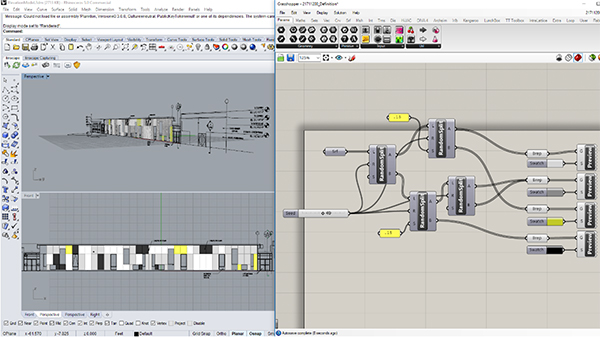
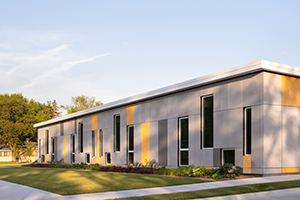
Parametric Design and Immersive Simulation
Although the yellow and gray stripes on the exterior fiber cement panels appear random, the team put a great deal of effort into the stripes’ placement using a concept called “parametric design.” It involves feeding parameters into a computer program that produces hundreds of alternatives based on mathematical algorithms. The team then debated the options and selected the most visually appealing one.
Another benefit of parametric design is minimized waste. Johnson said, “We encoded maximum panel sizes into the software so that any panels that were cut could be reused within the project.”

The design team also created a 3D model of the building. This “immersive simulation technology” allowed department heads and staff to take a virtual walk-through of the building to experience everything from overall layout and finish options to door types and hardware. They then shared their feedback with the design team.
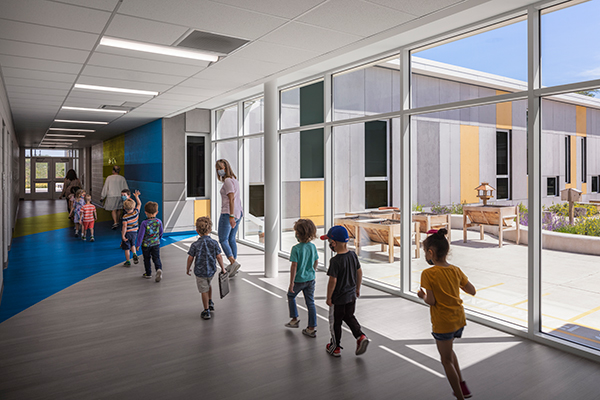

Interiors: A Wheaton- and Teacher-inspired Color Palette
On the first day of school, one Jefferson student told a new friend to stand on the green line in the hallway—that’s where their classmates line up. This example shows how the colors embedded in the design help Jefferson students navigate their school.
After teachers revealed they put tape on the floor of the old Jefferson so that students knew where to line up, the interiors team integrated colorful stripes into the luxury vinyl tiles within the new school’s classroom wing. Green guides students through the corridor, while blue identifies classroom locations. In the motor skills room, a large green circle on the floor echoes the elliptical shape of the concrete path in the courtyard. Students like to follow the shape when riding trikes, running, or doing other activities.
To create the school’s color scheme, the interiors team took cues from several Wheaton landmarks including the train station (also designed by Legat) and the Adams Park fountain, as well as from neighborhoods near the school.
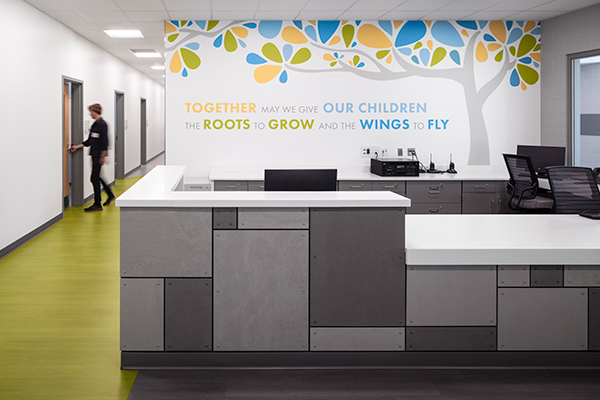
“We wanted to make the colors bright and joyful,” said Legat’s Aileen Everitt, interior designer. “After the teachers suggested combining a few of the colors we presented, we ended up with a palette that includes a cheerful green, soothing blue, and upbeat yellow.”
Behind the reception desk, a wall graphic designed by Legat graphic designer Amy Myoung incorporates the color scheme. The concept stems from brainstorming sessions with teachers and staff. Everitt said, “The district came up with tree as a symbol for growth, so Amy paired it with the quote and used the colors to capture the Jefferson spirit.”
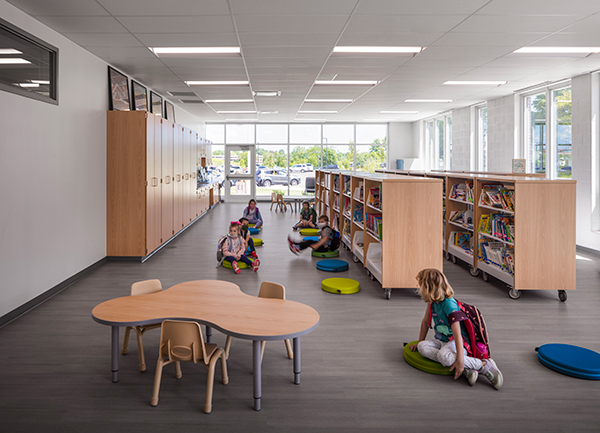
COVID Response
Opening a new school amid the COVID-19 pandemic posed a major challenge. Jefferson’s central courtyard proved helpful: classes came out in 20-minute increments to keep students six feet apart.
Mangini explained another benefit of the new school: “We weren’t anticipating COVID, but the flexible furniture helped us maintain social distancing.” For instance, staff wheeled shelving units to the perimeter of the learning resource center to keep students separated while they waited for cars or buses. Additionally, the disk-shaped mats in the corridor helped keep students socially distanced.
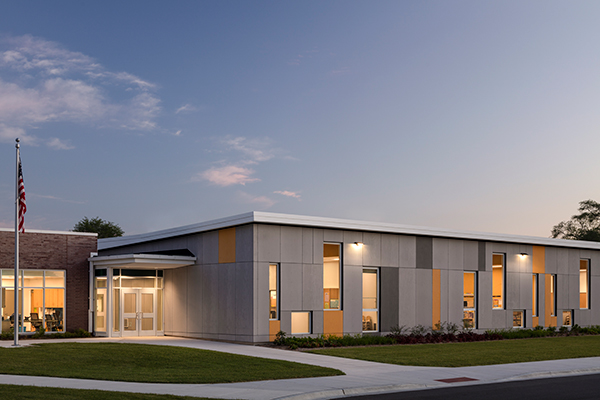
They Can and They Will
The impact of Jefferson Early Childhood Center became apparent to Mangini at the open house before the first day of school. “It was priceless to see the look on the parents’ and children’s faces when they first saw the new school and it was even better when they toured the facility and experienced its many highlights: bright and colorful rooms with staggered windows, the sensory courtyard that fosters play using natural materials and the environment, and the inclusive playground that allows our special needs children to play with their peers without looking different but getting the support that they need.”
She attributes Jefferson Early Childhood Center’s child-focused design to input from not only administrators, teachers, and parents, but also from specialists ranging from physical and occupational therapists to speech and language pathologists.
Parents new to Jefferson sometimes express concern that their disabled children will be unable to do certain things. The teachers’ response is typically some variation of the following: “Never assume that your children cannot—always assume that they can and they will.”
“Within the space that we’ve created at Jefferson Early Childhood Center,” said Mangini, “there will be a lot of cans and wills not only for this year, but for many years into the future.”
Contact us to learn more about educational design or comment below to share your thoughts on this post.


